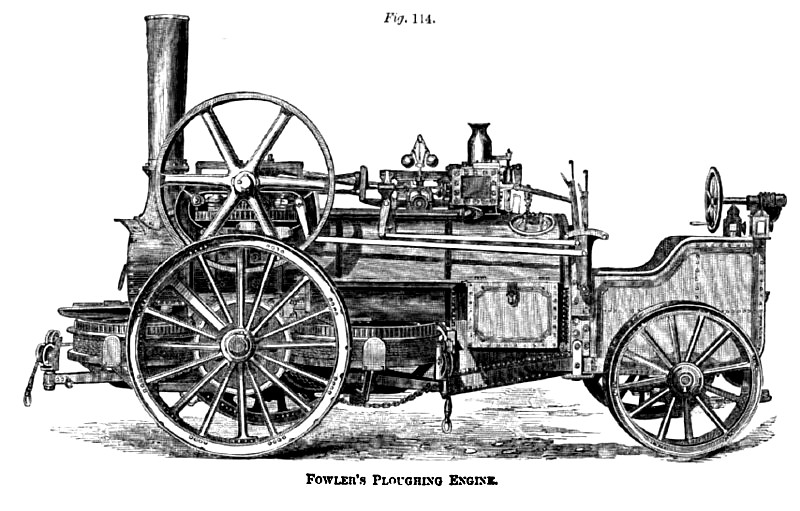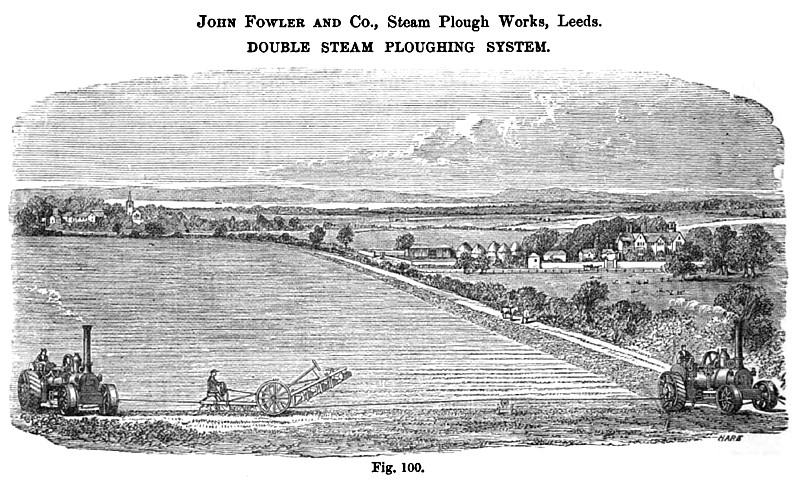|
Title: |
1878 Article-John Fowler & Co., Steam Ploughing Traction Engine |
|
Source: |
International Exhibition at Paris, 1878, pg. 69 |
|
Insert Date: |
2/7/2015 4:48:17 PM |
In this system two engines, fitted with wind- placed on opposite headlands of the field, each fitted with winding drums, are required. The engines are alternately drawing the implement towards itself, the one not in work paying out the rope while moving forward into position ready for the return journey of the implement. This arrangement requires no fixtures in the field, is most suitable for general purposes, and is especially adapted for carrying on, besides the heavier work of cultivation, all the lighter operations of the farm, such as harrowing, rolling, drilling, &c The rope may be used with advantage by reason of the directness of the pull exercised by it for hauling out roots and stones, tearing down trees, clearing land, for the removal of heavy agricultural produce, such as beet root, sugar canes, &c, from the fields to the headlands or the proper roads of the farm. Although the first cost of this plant is heavy it has been proved to be the cheapest system that can be adopted wherever the engines can be fully employed, there being no difficulty either in starting the engines and implements to work or in taking them up, and no time is wasted in having to fix any stationary apparatus. The engines are ready to start into a fresh field the moment they stop work, and can remove themselves and the whole of the machinery without any additional manual or animal labor. Where fields are small or very irregular, or where, as in new countries, the steam-plough cannot depend on any prompt assistance for removals, or where the distance between the fields is considerable, this tractive power is of great importance. It likewise gives a further advantage, as by its means implements of largo size may be used, which otherwise would not be the case as they could not readily be moved from field to field. For the cultivation of light lands, which in an economical point of view is only practicable by employing implements of very great breadth, this system is most useful.
The engines of this system are made from 6 to 20 horse-power. There were two exhibited at the Exhibition, of 16 horse-power and 6 horsepower respectively. The latter size has only lately been introduced, in order to supply a cheap set of ploughing tackle for the use of small farms. The plan of working is the same, two engines pulling the implement alternately between them; the speed of the rope is however somewhat reduced so as to increase its hauling power in proportion, and implements of less width are used, performing the same quality of work as the larger ones, but of course doing a less quantity per day. These small engines are easily made use of for threshing and can be transformed very speedily into ordinary traction engines, by taking down the drum and slipping the fore-carriage back on a special bracket provided for the purpose so as to shorten the length of the engine.
All the sizes of engines are now made with single steam jacketed cylinders, and are provided with steam domes. The road gear is constructed of spur wheels, and is made entirely of the best crucible cast-steel. The road wheels are of wrought-iron, from 14 to 24 in. wide, and at a cost of 30s. per inch they can be made to any extra width required by the class of soil. They are fitted with two rates of traveling speed.
The power is conveyed to the winding drum by an upright shaft from the crankshaft. The winding apparatus consists of a horizontal drum, which by means of a patent coiling gear winds and unwinds the wire rope uniformly without any attention from the man in charge. This is effected by a self-acting lever, which carries two vertical guide pulleys, moving slowly up and down and freely swinging round the drum into any position at which the rope has to work. Thus all undue strain on the rope as well as on the apparatus is avoided. The rope is made entirely from steel, about 800 yards being supplied with each set of ploughing engines, together with 10 rope porters. Steel has lately been extensively made use of in the whole machinery. In the case of the 16 horse-power engine exhibited, the boiler and fire box were made of steel, the boiler barrel being formed from one plate. |
|
 1878 John Fowler & Co., Steam Ploughing Traction Engine
1878 John Fowler & Co., Steam Ploughing Traction Engine
 1878 John Fowler & Co., Steam Ploughing Traction Engines
1878 John Fowler & Co., Steam Ploughing Traction Engines
|
|